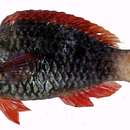Comprehensive Description
(
İngilizce
)
Smithsonian Contributions to Zoology tarafından sağlandı
Scarus frenatus Lacepède
Scarus frenatus Lacepède, 1802, pp. 3, 12, pl. 1: fig. 1.—Schultz, 1958, p. 83, fig. 13.—Randall, 1963, p. 226, pl. 1D, E.
Callyodon frenatus.—Smith, 1959, pp. 271, 279, pl. 41C—Fourmanoir, 1957, p. 187 [Nossi-Bè].
Scarus sexvittatus Rüppell, 1835, p. 26.—Randall, 1963, pl. 1D, E.
Callyodon sexvittatus—Smith, 1959, pp. 270, 279, fig. 2, pl. 41H, I.
Callyodon vermiculatus Fowler and Bean, 1928, p. 472, pl. 49 [holotype USNM 89978].—Smith, 1956, p. 11, pl. 41C.
Scarus vermiculatus.—Schultz, 1958, p. 82, pl. 16A.—Kamohara, 1963, p. 14, pl. 5: fig. 1 [Japan].—Woodland and Slack-Smith, 1963, p. 46 [Heron Island].
Callyodon upolensis [not Jordan and Seale] Smith, 1956, p. 11, pl. 41H, I.
Scarus randalli Schultz, 1958, p. 97, fig. 20, pls. 19C, 27A.
Characterized by having 6 or 7 median predorsal scales, 3 rows on cheek with 2 or 3 scales in ventral row, ii,12 pectoral rays, rarely ii,13; lips not covering teeth, white in young and females, green in adult males. Color pattern of adult males and females strikingly different: juveniles and adult females reddish brown, 5 dark lengthwise streaks alternating with light yellowish brown interspaces; all fins red; caudal peduncle and basal portion of caudal fin abruptly light yellowish or whitish. Mature males bright green, spotted with orange dorsally above lower edge of eye, below which head is green (pale in alcohol) with red markings; scales with vermiculations on lower sides. Caudal peduncle and caudal fin bright green (pale in alcohol), with an orange new-moon-shaped mark occupying basal part of that fin; anal and dorsal orange margined with blue; edges of both lips narrowly red then submarginally green.
Smith (1959, pp. 270, 279, fig. 2, pl. 41 H, I) has correctly referred S. randalli Schultz to the synonymy of this species and Randall (1963, p. 226) has shown that S. frenatus Lacepède is the adult male and S. sexvittatus is the female and immature stages.
Through an oversight, Pseudoscarus frenatus (not Lacepède) Bleeker, 1862 (p. 40, pl. 16: fig. 2), was not removed by Schultz (1958, p. 83) from the synonymy of S. frenatus Lacepède to that of S. flavipectoralis Schultz, 1958 (p. 52), where it belongs.
Callyodon pectoralis [not Cuvier and Valenciennes] Smith, 1956 (p. 15, pl. 42J), has been found to be an illustration of S. cyanognatus Bleeker, to which it is assigned in this paper.
I have studied recently collected specimens as follows: Dr. Steinitz loaned one 290-mm specimen from the Red Sea; two 96- and 210-mm specimens were collected by the IIOE in the Aldabra Islands; USNM 202666 was collected by the IIOE at the Comoro Islands; one specimen from Sta. HA67–5, Diego Garcia Atoll, 13 June 1967, is 290 mm in length. Dr. Randall collected three, 255–295 mm, at Papeete, USNM 202693 and 202694.
RANGE.—Central and western Pacific Ocean, Indian Ocean, and Red Sea.
- bibliyografik atıf
- Schultz, Leonard P. 1969. "The taxonomic status of the controversial genera and species of parrotfishes with a descriptive list (family Scardiae)." Smithsonian Contributions to Zoology. 1-49. https://doi.org/10.5479/si.00810282.17

